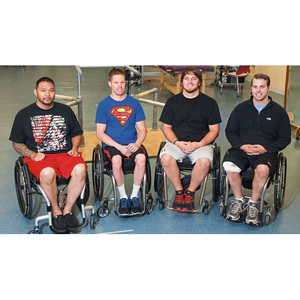Electrical implants let paralysed patients stand again
Electrical implants let paralysed patients stand again
An electrical implant has helped four paralyzed men move their legs again through an electrical implant which when activated allows the men to move their toes and legs.
Experts say it's a promising development but warn that the experimental treatment isn't a cure.
Almost three years ago doctors announced that zapping an electrical impulse to the spinal cord would allow someone to move and stand. Since this they have carried out the same test with three other patients to prove that it was not just a one off.
'There is no miracle cure on the way,' said Peter Ellaway, an emeritus professor of physiology at Imperial College London, who had no role in the study.
'But this could certainly give paralyzed people more independence and it could still be a life-changer for them.'
In a new study published Tuesday in the British journal Brain, researchers gave an update on Rob Summers, of Portland, Oregon, the first to try the treatment, and described successful results for all three of the other men who have tried it.
All had been paralyzed from below the neck or chest for at least two years from a spinal cord injury.
Dustin Shillcox, 29, of Green River, Wyoming, was seriously injured in a car crash in 2010.
Last year, he had the electrical device surgically implanted in his lower back in Kentucky. Five days later he was able to move his toes and feet for the first time.
Shillcox now practices moving his legs for about an hour a day at home in addition to therapy sessions in the lab, sometimes wearing a Superman T-shirt for inspiration.
He said it has given him more confidence and he feels more comfortable going out.
'The future is very exciting for people with spinal cord injuries,' he said.
Experts said refining the use of electrical stimulators for people with paralysis might eventually prove more effective than standard approaches, including medicines and physical therapy.
'In the next five to 10 years, we may have one of the first therapies that can improve the quality of life for people with a spinal cord injury,' said Gregoire Courtine, a paralysis expert at the Swiss Federal Institute of Technology in Lausanne, who was not part of the study.

